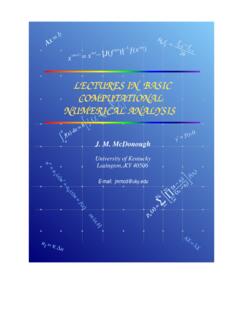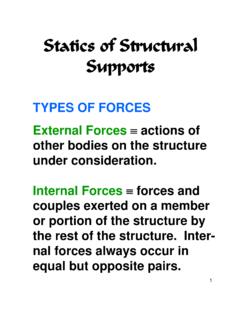Transcription of Introduction Finite Element Method of Analysis
1 1 Finite Element Methodof AnalysisIntroduction Engineers model physical phenomena. Analytical descriptions of physi-cal phenomena and processes are called mathematical models. Developed using assumptions on the process. Often characterized by differential and/or integral equations. Numerical methods are typically used to solve engineering mathematical models referred to as numerical Element Method Finite Element Method (FEM) is a numerical procedure for solving mathematical models numerically. FEM uses discretization (nodes and elements ) to model the engineering system, , subdivide the problem system into small components or pieces called elements and the elements are comprised of nodes. Approximations are introduced over each Element to represent the behavior of the unknown con t Different types of elements are available. Accuracy of the Finite Element approximation is improved by using more elements to approximate the engineering system and/or elements that involve more nodes to define the unknown function(s) variation over the Element , , Q4 Bilinear ElementQ9 Biquadratic Element2 FEA ProcessSample FE MeshesBasic Components of FEA1) Definition of the geometric form of the ) Representation of the assumed modes of behavior; generally polynomial ) Construction of the algebraic equations that correspond to the governing equations of the Summary1.
2 Divide the structure or continuum into Finite elements . Mesh generation programs, call preprocessors, help the user in doing this Formulation the properties of each Element . In stress Analysis , this means determining nodal loads associated with all Element deformation states that are allowed. In heat transfer, it means determining nodal heat fluxes associated with all Element temperature Summary con t3. Assemble elements to obtain the Finite Element model of the structure or Apply the known loads: nodal forces and/or moments in stress Analysis ; nodal heat fluxes in heat In stress Analysis , specify how the structure is supported. This step involves specifying the known nodal displacements, which are often zero. In heat transfer, impose all known values of nodal temperature. FEM Summary con t6. Solve simultaneous linear algebraic equations to determine nodal degrees of freedom (dof) displacements for stress Analysis and temperature for heat (a) In stress Analysis , calculate Element strains for the nodal dof and the Element displacement interpolation field so that the Element stresses can be calculated from the Element Summary con t7.
3 (b) In heat transfer Analysis , calculate Element heat fluxes from the nodal temperatures and the Element temperature interpolation Output interpretation programs, call postprocessors, help the user sort the output and display it in graphical Beam ElementGoverning Equation:Variables:w = transverse displacementE = elastic modulusI = moment of inertiacf= foundation modulusq(x) = distributed load = domain (0 x L)413 Beam Finite Element Analysis1415 Weighted Residual Formv(x) weighting functionFirst Integration by Parts16 Symmetric Weak Form517 Natural Boundary Conditions:18 Essential Boundary Conditions:19 Hermite cubic shape functions:20 Finite Element CalculationsSubstitutinginto the symmetric weak form leads to621 Element Equationsoror Element stiffness equations22= Element stiffness matrix coefficients= Element load vector componentsExplicit expressions for [ke] and {Fe} (uniform load) are given in Eqs.
4 ( ), see next Assembly725 Force Equilibrium:Displacement Continuity ( ):2627 Boundary Conditions28 Finite Element Bending Moment Calculation.



















